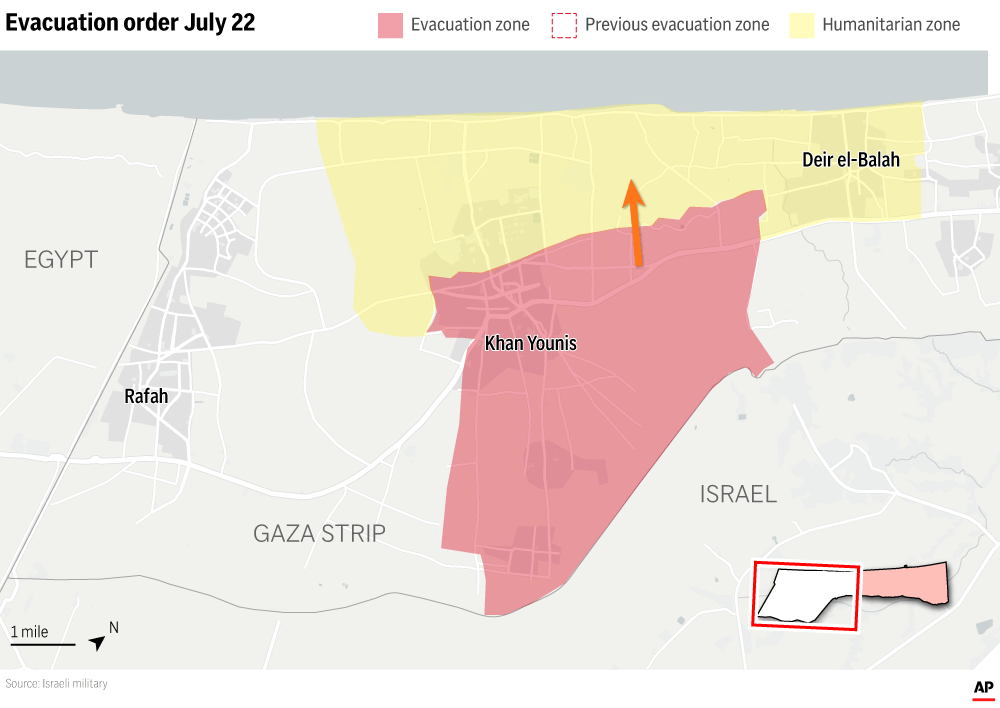DEIR AL-BALAH, Gaza Strip (AP) — Young girls scream and shove each other in a crush in the southern Gaza Strip as they desperately try to get to the front of the food line. Men hand out rice and chicken as quickly as they can, and entire plates of food fall to the ground in the commotion.
Nearby, boys waited to fill plastic containers with water, standing for hours between tents that were so tightly packed they almost touched.
Hunger and desperation were palpable in the tent camp on the seafront in Deir al-Balah on Friday, after several evacuation orders were issued over the past month and thousands of Palestinians were pushed into the area the Israeli military calls a “humanitarian zone.”
The zone has long overcrowded of Palestinians seeking refuge from bombs, but the situation is getting worse by the day as waves of evacuees arrive and food and water become scarce. Last month, the Israeli military issued evacuation orders for southern Gaza, unprecedented pace.
At least 84 percent of the Gaza Strip is now in the evacuation zone, according to the UN. It also estimates that 90 percent of Gaza’s 2.1 million residents have been displaced during the war.
According to an Associated Press count, 13 evacuation orders have been issued since July 22, significantly shrinking the humanitarian zone declared by Israel at the start of the war while pushing more Palestinians into it than ever before. The increasing crush of evacuees can be seen in satellite photos.

Evacuation orders for residents of the Gaza Strip have been in effect since July 22.
“The food we receive from the aid organization is enough for the people in our camp,” said Muhammad Al-Qayed, who was displaced from Gaza City and now lives on the beach. “Where do the people who were recently displaced get food? Where do we feed them?”
Another displaced Palestinian, Adham Hijazi, said: “I started thinking that if there is nothing to eat, I will drink sea water to survive. I am serious. I will drink water and salt.”
The military says the evacuations are necessary because Hamas has fired rockets from the humanitarian zone. In posts on X, the military’s Arabic-speaking spokesman, Avichay Adraee, called on Palestinians to flee immediately and said the military would soon take “forceful action” against Hamas militias in the area.
Yasser Felfel, who was originally displaced from northern Gaza, watched as his camp swelled with waves of evacuees.
“There were 32 people in my tent. Now there are almost 50 people, people I don’t know,” he said. “A week ago there was a lot of food left over. We had breakfast, lunch and dinner. Today there is barely enough for lunch because of the number of people who have come here.”
In August alone, evacuation orders were issued approximately every two days, causing nearly 250,000 people to flee, the United Nations said.
“Many people here have been displaced more than 10 times. They are exhausted and broke,” said Georgios Petropoulos, head of the UN Office for the Coordination of Humanitarian Affairs in Gaza.
Two satellite photos taken last month show the impact of the orders. The images, obtained by PlanetLabs and reviewed by AP, show that tent camps along the coast became more densely packed between July 19 and August 19.
By August 19, almost all available sandy areas were covered with tents set up closer to the sea.
Even Palestinians living in the humanitarian zone that Israel declared at the start of the war were forced to leave their homes. On July 22, the military ordered the evacuation of most of the eastern edge of the zone, citing Hamas’s rocket fire at Israel. On August 16, the military reduced the zone again and told Palestinians living in the center to flee.
The evacuations are carried out as international mediators struggle to build a bridge Disagreements between Israel and Hamas over a ceasefire agreement that would end fighting in the Gaza Strip and exchange numerous Israeli hostages for Palestinian prisoners.
The war began on October 7, when Hamas fighters crossed the Israeli border, killing about 1,200 people and taking about 250 hostage. Israel’s retaliatory offensive has now over 40,000 people in Gaza and destroyed the buildings and infrastructure of the strip.
The water supply is also a victim of the evacuations. According to the UN, the water supply in Deir al-Balah has fallen by at least 70 percent since the start of the latest wave of evacuations, as pumps and desalination plants are located in the evacuation zones.
The lack of clean water causes Skin diseases and other outbreaksThe UN’s main health authority confirmed First polio case in Gaza with a 10-month-old baby in Deir al-Balah, whose left lower leg is now paralyzed.
Aid groups, meanwhile, say it is becoming increasingly difficult to offer assistance. UN spokesman Stephane Dujarric said on Thursday that the United Nations World Food Programme had lost access to its camp in the centre of Deir al-Balah due to a recent evacuation order.
As Abu Mohammad stood in the water pipe on Friday, he observed the shortage around him and prayed that it would soon end.
“There is no water, there is no food, there is no money, there is no work, there is nothing,” said Mohammad, who has now been displaced seven times.
“We ask God, not man, to stop it. We are no longer able to do it. Oh world, we are no longer able to do it.”
___
Frankel reported from Jerusalem.
